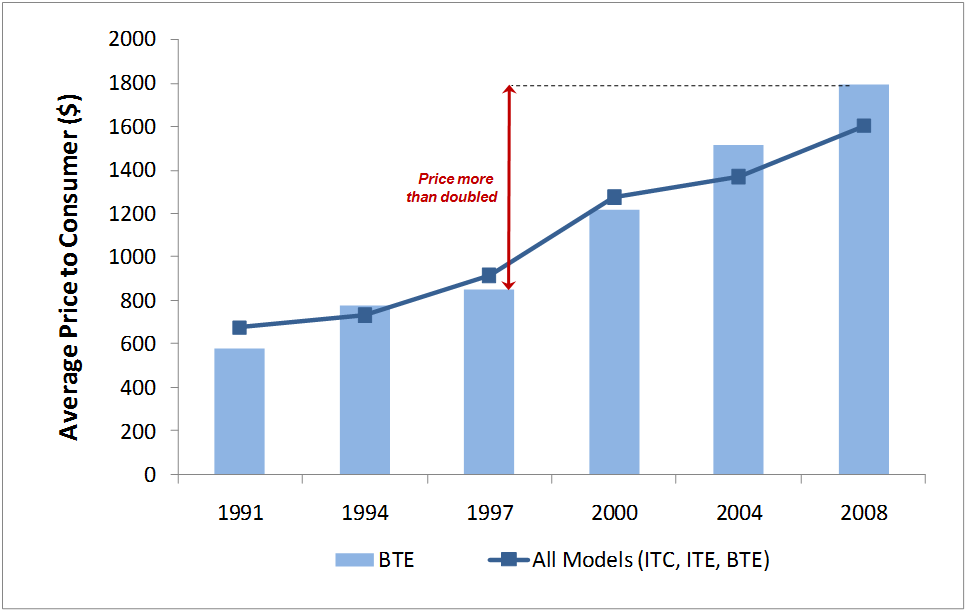If you have been through the process of getting a hearing aid, you probably scratched your head when looking at the bill.
Hearing aid prices can range from $1,500 to $3,500 per unit. According to the President's Council for Science & Technology, the average price is $2,300 per unit.
You can double that cost if you need one for each ear.
To the average American household, the cost of hearing aids adds up to around 2 months of income! In other words, hearing aids aren't exactly cheap.
Below we explain why hearing aids are so expensive and the options currently available for low-cost hearing aids.

Escalation Of Hearing Aid Prices: Why Are There No Low-cost Hearing Aids?
While the price itself seems exorbitant, the continuous pace of growth is even worse. In the last decade, the price of an average Behind-the-Ear (BTE) hearing aid has more than doubled. Even today, price points continue to trend up. Low-cost hearing aids are rarely offered by the main hearing aid models offered in most in-person audiology clinics.
Send Us Your Audiogram for a Free Consultation
While you might be thinking the features and technology advancements justify the costs - the math doesn't add up. Most major manufacturers have shifted their production to low-cost China (e.g. Phonak), which only drives business costs down. Unfortunately, manufacturers have not passed their savings back to the consumer. Since most hearing aids today are made up of digital signal processors, we would expect costs to have dropped over time. Digital technology, in theory, should reduce production costs in the same way that it has for most consumer electronics. For a while, increasing amounts of R&D spending shifted towards developing sophisticated signal processing software capable of tackling anything from complex speech recognition situations to effective noise cancellation. These features have now become standard too. Components cost at most $50 to $150 per device but can go as low as a few dollars. As technology advances and goods cost less and less to make, it only makes sense for technology to become more affordable to the average consumer. A good example of this is your old DVD player. The cost of an average DVD player has plunged over the last two decades. Because of this, you can buy a DVD player today for next to nothing. So what makes hearing aids so expensive? Why have hearing aids costs risen while the rest of consumer goods has dropped? The reason for this is hearing aids are commoditized.Manageable Hearing Aid Prices: Where Are The More Low-cost Hearing Aids?
Manufacturers have spent substantial R&D resources making the devices smaller, more powerful, and packed with myriads of new features: Bluetooth, wireless integration, remote controls, 20+ channels. The improvements in alleviating hearing loss are marginal for most people. This is because there is no notable perceived benefit beyond 4-5 channels. Many argue that devices nowadays are over-engineered for the average user with mild or moderate hearing loss. Over-engineering gives manufacturers an excuse to charge higher prices by introducing “newer and better” models. This is in large part why so many consumers feel the costs of hearing aids today are a rip-off. Think about it this way: if you need to get from A to B, a Rolls Royce would definitely make the ride more enjoyable than a Honda. On the other hand, the Honda will get you from A to B just as well - in a safe and comfortable manner. It seems that when it comes to hearing aids you don’t have the choice to opt for the Honda: you are forced to buy the Rolls Royce. The most important factor for the current hearing aid price levels has to do with the underlying industry structure. The relationship between manufacturers, audiologists, and end-patients plays a role in the prices we see. Have you ever wondered how a few components costing at most $100, assembled in China, suddenly turn into a $2,500 hearing aid? While many recent events suggest that low-cost hearing aids might be right around the corner (Audicus is one example) this pricing bubble is material for many posts to come. Read more about the rising hearing aid prices versus other consumer electronics. Want more information on affordable hearing aids? Check out our site. Sources: Audicus Hearing Aids, Marke Trak VIII, Audiology OnlineHave an Audiogram Already? Send It to Us




